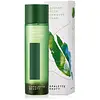What's inside
What's inside
 Key Ingredients
Key Ingredients

 Benefits
Benefits

 Concerns
Concerns

No concerns
 Ingredients Side-by-side
Ingredients Side-by-side

Centella Asiatica Extract
Cleansing1,2-Hexanediol
Skin ConditioningNiacinamide
SmoothingPentylene Glycol
Skin ConditioningButylene Glycol
HumectantGlycerin
HumectantPropanediol
SolventBetaine
HumectantAllantoin
Skin ConditioningPanthenol
Skin ConditioningMadecassoside
AntioxidantXylitylglucoside
HumectantAnhydroxylitol
HumectantXylitol
Humectant3-O-Ethyl Ascorbic Acid
Skin ConditioningPrunus Mume Fruit Extract
HumectantPyrus Malus Fruit Extract
Skin ConditioningCarica Papaya Fruit Extract
Skin ConditioningVitis Vinifera Fruit Extract
Skin ConditioningCaprylic/Capric Triglyceride
MaskingWater
Skin ConditioningGlucose
HumectantDisodium EDTA
Xanthan Gum
EmulsifyingEthylhexylglycerin
Skin ConditioningCentella Asiatica Extract, 1,2-Hexanediol, Niacinamide, Pentylene Glycol, Butylene Glycol, Glycerin, Propanediol, Betaine, Allantoin, Panthenol, Madecassoside, Xylitylglucoside, Anhydroxylitol, Xylitol, 3-O-Ethyl Ascorbic Acid, Prunus Mume Fruit Extract, Pyrus Malus Fruit Extract, Carica Papaya Fruit Extract, Vitis Vinifera Fruit Extract, Caprylic/Capric Triglyceride, Water, Glucose, Disodium EDTA, Xanthan Gum, Ethylhexylglycerin
Camellia Sinensis Leaf Extract
AntimicrobialDipropylene Glycol
HumectantGlycerin
HumectantPropanediol
Solvent1,2-Hexanediol
Skin ConditioningCamellia Sinensis Leaf Water
MaskingPPG-13-Decyltetradeceth-24
EmulsifyingHydroxyacetophenone
AntioxidantCamellia Sinensis Leaf Powder
ExfoliatingCaprylyl Glycol
EmollientButylene Glycol
HumectantWater
Skin ConditioningCarbomer
Emulsion StabilisingTromethamine
BufferingCinnamomum Camphora Bark Oil
MaskingDisodium EDTA
Gluconolactone
Skin ConditioningCitric Acid
BufferingAllantoin
Skin ConditioningGaultheria Procumbens Leaf Extract
PerfumingPentylene Glycol
Skin ConditioningPelargonium Graveolens Flower Oil
MaskingPogostemon Cablin Leaf Oil
MaskingLitsea Cubeba Fruit Oil
MaskingDipotassium Glycyrrhizate
HumectantCitrus Limon Peel Oil
MaskingRosmarinus Officinalis Leaf Oil
MaskingSalvia Officinalis Oil
MaskingMelaleuca Alternifolia Leaf Oil
AntioxidantTocopherol
AntioxidantCamellia Sinensis Leaf Extract, Dipropylene Glycol, Glycerin, Propanediol, 1,2-Hexanediol, Camellia Sinensis Leaf Water, PPG-13-Decyltetradeceth-24, Hydroxyacetophenone, Camellia Sinensis Leaf Powder, Caprylyl Glycol, Butylene Glycol, Water, Carbomer, Tromethamine, Cinnamomum Camphora Bark Oil, Disodium EDTA, Gluconolactone, Citric Acid, Allantoin, Gaultheria Procumbens Leaf Extract, Pentylene Glycol, Pelargonium Graveolens Flower Oil, Pogostemon Cablin Leaf Oil, Litsea Cubeba Fruit Oil, Dipotassium Glycyrrhizate, Citrus Limon Peel Oil, Rosmarinus Officinalis Leaf Oil, Salvia Officinalis Oil, Melaleuca Alternifolia Leaf Oil, Tocopherol
 Reviews
Reviews

Ingredients Explained
These ingredients are found in both products.
Ingredients higher up in an ingredient list are typically present in a larger amount.
1,2-Hexanediol is a synthetic liquid and another multi-functional powerhouse.
It is a:
- Humectant, drawing moisture into the skin
- Emollient, helping to soften skin
- Solvent, dispersing and stabilizing formulas
- Preservative booster, enhancing the antimicrobial activity of other preservatives
Allantoin is a soothing ingredient known for its protective and moisturizingg properties. Because of this, it is often added to products with strong active ingredients.
Studies show higher concentrations of this ingredient can promote wound healing.
Though it can be derived from the comfrey plant, allantoin is produced synthetically for cosmetic products to ensure purity.
Learn more about AllantoinButylene Glycol (or BG) is used within cosmetic products for a few different reasons:
Overall, Butylene Glycol is a safe and well-rounded ingredient that works well with other ingredients.
Though this ingredient works well with most skin types, some people with sensitive skin may experience a reaction such as allergic rashes, closed comedones, or itchiness.
Learn more about Butylene GlycolDisodium EDTA plays a role in making products more stable by aiding other preservatives.
It is a chelating agent, meaning it neutralizes metal ions that may be found in a product.
Disodium EDTA is a salt of edetic acid and is found to be safe in cosmetic ingredients.
Learn more about Disodium EDTAGlycerin is already naturally found in your skin. It helps moisturize and protect your skin.
A study from 2016 found glycerin to be more effective as a humectant than AHAs and hyaluronic acid.
As a humectant, it helps the skin stay hydrated by pulling moisture to your skin. The low molecular weight of glycerin allows it to pull moisture into the deeper layers of your skin.
Hydrated skin improves your skin barrier; Your skin barrier helps protect against irritants and bacteria.
Glycerin has also been found to have antimicrobial and antiviral properties. Due to these properties, glycerin is often used in wound and burn treatments.
In cosmetics, glycerin is usually derived from plants such as soybean or palm. However, it can also be sourced from animals, such as tallow or animal fat.
This ingredient is organic, colorless, odorless, and non-toxic.
Glycerin is the name for this ingredient in American English. British English uses Glycerol/Glycerine.
Learn more about GlycerinPentylene glycol is typically used within a product to thicken it. It also adds a smooth, soft, and moisturizing feel to the product. It is naturally found in plants such as sugar beets.
The hydrophilic trait of Pentylene Glycol makes it a humectant. As a humectant, Pentylene Glycol helps draw moisture from the air to your skin. This can help keep your skin hydrated.
This property also makes Pentylene Glycol a great texture enhancer. It can also help thicken or stabilize a product.
Pentylene Glycol also acts as a mild preservative and helps to keep a product microbe-free.
Some people may experience mild eye and skin irritation from Pentylene Glycol. We always recommend speaking with a professional about using this ingredient in your routine.
Pentylene Glycol has a low molecular weight and is part of the 1,2-glycol family.
Learn more about Pentylene GlycolPropanediol is an all-star ingredient. It softens, hydrates, and smooths the skin.
It’s often used to:
Propanediol is not likely to cause sensitivity and considered safe to use. It is derived from corn or petroleum with a clear color and no scent.
Learn more about PropanediolWater. It's the most common cosmetic ingredient of all. You'll usually see it at the top of ingredient lists, meaning that it makes up the largest part of the product.
So why is it so popular? Water most often acts as a solvent - this means that it helps dissolve other ingredients into the formulation.
You'll also recognize water as that liquid we all need to stay alive. If you see this, drink a glass of water. Stay hydrated!
Learn more about Water